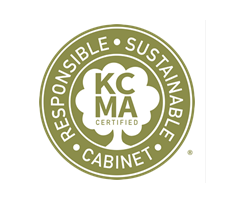

RESTON, VA. – The Kitchen Cabinet Manufacturers Association (KCMA) has published a new infographic that explains how the Environmental Stewardship Program (ESP) compares to other certification programs and offers the most comprehensive approach to achieving sustainability in both the environment and the communities served by cabinet manufacturers.
“This handy reference spells out exactly what architects should be looking for in the cabinets they specify,” says KCMA CEO Betsy Natz. “The infographic helps raise awareness about the importance of sustainability in design, educating architects and their customers about practical differences between such programs as they integrate sustainable practices into their work. It’s not only a great reference; it can serve as a key selling tool with their customers on their commitment to sustainability.”
The KCMA infographic is divided into seven key categories, with an explanation of the requirements of each category in easy-to-read language. The categories are: General Information, Air Quality and Pollution Prevention, Resource Sustainability, Waste Minimization, Environmental Stewardship, Community Relations, and Green Building Requirements.
“The whole point of our KCMA Environmental Stewardship Program (ESP) is that it allows our certification participants to shape the program to their needs and the needs of their customers,” explains Chuck Arnold, Vice President Standards & Certification at KCMA. “There is no one size fits all in the world of environmental sustainability and respecting what is around us. That’s why the KCMA ESP program was created to be flexible, comprehensive and of practical, real value.”
By detailing examples of the categories of sustainability, the infographic inspires architects with ideas and approaches to incorporate sustainability into their design specifications. Using a handy checklist, the infographic offers practical guidance and serves as a resource to help architects navigate the complexities of sustainable design by comparing programs, making it easier for them to implement sustainability initiatives in their work.
“The infographic equips architects with information for measuring the differences in programs as they evaluate the environmental impact of their designs,” Natz points out. “It empowers them to make informed decisions and make progress toward their sustainability goals by incorporating the language of sustainability into their specifications, as well as noting the ESP program itself.”
Arnold says that participants in ESP get to select items out of the 5 chapters of ESP to comply with to earn at least 70 points. “Participants don’t just wave a magic wand to achieve compliance,” he adds. “ESP is a commitment that must stand the tests of not only the program itself, but the tests of time. That’s why it’s the preferred program for cabinet manufacturers.”
The infographic for how the KCMA Environmental Stewardship Program (ESP) compares to other certification programs is available on the KCMA website: https://kcma.org/resources/comparison-green-cabinet-certification-programs-0
For more information on the KCMA Environmental Stewardship Program(ESP), please contact Chuck Arnold, Vice President, Standards & Certification, Phone: (703) 264-1690, Email: Chuck Arnold carnold@kcma.org.
# # #
ABOUT KCMA.
The Kitchen Cabinet Manufacturers Association (KCMA) is a non-profit organization founded in 1955 to represent companies who manufacture cabinets, bath cabinets, or other residential cabinets and key kitchen and bath industry suppliers. With a membership now more than 300 strong throughout North America, KCMA works to advance the cabinet industry through advocacy, setting cabinet quality standards, sponsoring kitchen and bath cabinet-related research, and providing the cabinet industry with management tools and educational programs.
EDITOR’S NOTE: To arrange an interview with Betsy Natz, Chief Executive Officer for KCMA, please contact Mujahid Tarshi, Phone: (703) 592 - 4424, Email: Mujahid Tarshi mtarshi@kcma.org


